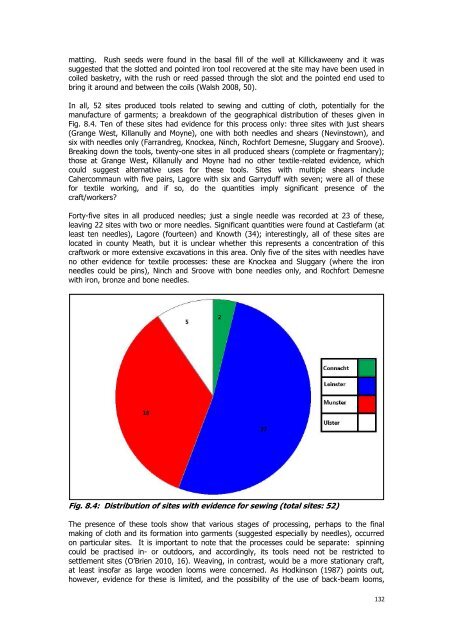EMAP_2012_Report_6_1.pdf (7.3 MB) - The Heritage Council
EMAP_2012_Report_6_1.pdf (7.3 MB) - The Heritage Council
EMAP_2012_Report_6_1.pdf (7.3 MB) - The Heritage Council
Create successful ePaper yourself
Turn your PDF publications into a flip-book with our unique Google optimized e-Paper software.
matting. Rush seeds were found in the basal fill of the well at Killickaweeny and it was<br />
suggested that the slotted and pointed iron tool recovered at the site may have been used in<br />
coiled basketry, with the rush or reed passed through the slot and the pointed end used to<br />
bring it around and between the coils (Walsh 2008, 50).<br />
In all, 52 sites produced tools related to sewing and cutting of cloth, potentially for the<br />
manufacture of garments; a breakdown of the geographical distribution of theses given in<br />
Fig. 8.4. Ten of these sites had evidence for this process only: three sites with just shears<br />
(Grange West, Killanully and Moyne), one with both needles and shears (Nevinstown), and<br />
six with needles only (Farrandreg, Knockea, Ninch, Rochfort Demesne, Sluggary and Sroove).<br />
Breaking down the tools, twenty-one sites in all produced shears (complete or fragmentary);<br />
those at Grange West, Killanully and Moyne had no other textile-related evidence, which<br />
could suggest alternative uses for these tools. Sites with multiple shears include<br />
Cahercommaun with five pairs, Lagore with six and Garryduff with seven; were all of these<br />
for textile working, and if so, do the quantities imply significant presence of the<br />
craft/workers?<br />
Forty-five sites in all produced needles; just a single needle was recorded at 23 of these,<br />
leaving 22 sites with two or more needles. Significant quantities were found at Castlefarm (at<br />
least ten needles), Lagore (fourteen) and Knowth (34); interestingly, all of these sites are<br />
located in county Meath, but it is unclear whether this represents a concentration of this<br />
craftwork or more extensive excavations in this area. Only five of the sites with needles have<br />
no other evidence for textile processes: these are Knockea and Sluggary (where the iron<br />
needles could be pins), Ninch and Sroove with bone needles only, and Rochfort Demesne<br />
with iron, bronze and bone needles.<br />
Fig. 8.4: Distribution of sites with evidence for sewing (total sites: 52)<br />
<strong>The</strong> presence of these tools show that various stages of processing, perhaps to the final<br />
making of cloth and its formation into garments (suggested especially by needles), occurred<br />
on particular sites. It is important to note that the processes could be separate: spinning<br />
could be practised in- or outdoors, and accordingly, its tools need not be restricted to<br />
settlement sites (O’Brien 2010, 16). Weaving, in contrast, would be a more stationary craft,<br />
at least insofar as large wooden looms were concerned. As Hodkinson (1987) points out,<br />
however, evidence for these is limited, and the possibility of the use of back-beam looms,<br />
132
















